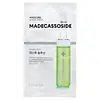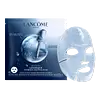What's inside
What's inside
 Key Ingredients
Key Ingredients

 Benefits
Benefits

 Concerns
Concerns

 Ingredients Side-by-side
Ingredients Side-by-side

Water
Skin ConditioningGlycerin
HumectantButylene Glycol
HumectantCaprylic/Capric Triglyceride
Masking1,2-Hexanediol
Skin ConditioningCentella Asiatica Leaf Extract
Skin ConditioningMadecassoside
AntioxidantButyrospermum Parkii Butter
Skin ConditioningMacadamia Integrifolia Seed Oil
Skin ConditioningPelargonium Graveolens Flower Oil
MaskingHydrogenated Lecithin
EmulsifyingPhytosteryl/Octyldodecyl Lauroyl Glutamate
Skin ConditioningCeramide NP
Skin ConditioningSodium Hyaluronate
HumectantButylene Glycol Dicaprylate/Dicaprate
EmollientCetyl Ethylhexanoate
EmollientTrehalose
HumectantSorbitan Sesquioleate
EmulsifyingCetearyl Alcohol
EmollientCarbomer
Emulsion StabilisingAllantoin
Skin ConditioningGlyceryl Stearate
EmollientHydroxyethylcellulose
Emulsion StabilisingPolyacrylate-13
Polyisobutene
Polysorbate 20
EmulsifyingSorbitan Isostearate
EmulsifyingBiosaccharide Gum-1
HumectantEthylhexylglycerin
Skin ConditioningPolysorbate 60
EmulsifyingDisodium EDTA
Water, Glycerin, Butylene Glycol, Caprylic/Capric Triglyceride, 1,2-Hexanediol, Centella Asiatica Leaf Extract, Madecassoside, Butyrospermum Parkii Butter, Macadamia Integrifolia Seed Oil, Pelargonium Graveolens Flower Oil, Hydrogenated Lecithin, Phytosteryl/Octyldodecyl Lauroyl Glutamate, Ceramide NP, Sodium Hyaluronate, Butylene Glycol Dicaprylate/Dicaprate, Cetyl Ethylhexanoate, Trehalose, Sorbitan Sesquioleate, Cetearyl Alcohol, Carbomer, Allantoin, Glyceryl Stearate, Hydroxyethylcellulose, Polyacrylate-13, Polyisobutene, Polysorbate 20, Sorbitan Isostearate, Biosaccharide Gum-1, Ethylhexylglycerin, Polysorbate 60, Disodium EDTA
Water
Skin ConditioningGlycerin
HumectantBifida Ferment Lysate
Skin ConditioningButylene Glycol
HumectantCaprylic/Capric Triglyceride
Masking1,2-Hexanediol
Skin ConditioningSucrose
HumectantLactobacillus Ferment
Skin ConditioningTocopherol
AntioxidantSodium Benzoate
MaskingMadecassoside
AntioxidantHydrolyzed Wheat Protein
Skin ConditioningSodium Dehydroacetate
PreservativeSodium Succinate
BufferingPhenoxyethanol
PreservativePhenyl Trimethicone
Skin ConditioningAdenosine
Skin ConditioningFaex Extract
Skin ConditioningPEG-60 Hydrogenated Castor Oil
EmulsifyingArginine
MaskingEthylhexylglycerin
Skin ConditioningPolyacrylate-13
Allantoin
Skin ConditioningPolyisobutene
Polysorbate 20
EmulsifyingSalicyloyl Phytosphingosine
Skin ConditioningLimonene
PerfumingPentylene Glycol
Skin ConditioningLinalool
PerfumingCeratonia Siliqua Gum
EmollientCarrageenan
Sorbitan Isostearate
EmulsifyingDisodium EDTA
Potassium Chloride
Citronellol
PerfumingPotassium Hydroxide
BufferingMethionine
Skin ConditioningPotassium Sorbate
PreservativeGlycine
BufferingParfum
MaskingWater, Glycerin, Bifida Ferment Lysate, Butylene Glycol, Caprylic/Capric Triglyceride, 1,2-Hexanediol, Sucrose, Lactobacillus Ferment, Tocopherol, Sodium Benzoate, Madecassoside, Hydrolyzed Wheat Protein, Sodium Dehydroacetate, Sodium Succinate, Phenoxyethanol, Phenyl Trimethicone, Adenosine, Faex Extract, PEG-60 Hydrogenated Castor Oil, Arginine, Ethylhexylglycerin, Polyacrylate-13, Allantoin, Polyisobutene, Polysorbate 20, Salicyloyl Phytosphingosine, Limonene, Pentylene Glycol, Linalool, Ceratonia Siliqua Gum, Carrageenan, Sorbitan Isostearate, Disodium EDTA, Potassium Chloride, Citronellol, Potassium Hydroxide, Methionine, Potassium Sorbate, Glycine, Parfum
Ingredients Explained
These ingredients are found in both products.
Ingredients higher up in an ingredient list are typically present in a larger amount.
1,2-Hexanediol is a synthetic liquid and another multi-functional powerhouse.
It is a:
- Humectant, drawing moisture into the skin
- Emollient, helping to soften skin
- Solvent, dispersing and stabilizing formulas
- Preservative booster, enhancing the antimicrobial activity of other preservatives
Allantoin is a soothing ingredient known for its protective and moisturizingg properties. Because of this, it is often added to products with strong active ingredients.
Studies show higher concentrations of this ingredient can promote wound healing.
Though it can be derived from the comfrey plant, allantoin is produced synthetically for cosmetic products to ensure purity.
Learn more about AllantoinButylene Glycol (or BG) is used within cosmetic products for a few different reasons:
Overall, Butylene Glycol is a safe and well-rounded ingredient that works well with other ingredients.
Though this ingredient works well with most skin types, some people with sensitive skin may experience a reaction such as allergic rashes, closed comedones, or itchiness.
Learn more about Butylene GlycolThis ingredient is an emollient, solvent, and texture enhancer. It is considered a skin-softener by helping the skin prevent moisture loss.
It helps thicken a product's formula and makes it easier to spread by dissolving clumping compounds.
Caprylic Triglyceride is made by combining glycerin with coconut oil, forming a clear liquid.
While there is an assumption Caprylic Triglyceride can clog pores due to it being derived from coconut oil, there is no research supporting this.
Learn more about Caprylic/Capric TriglycerideDisodium EDTA plays a role in making products more stable by aiding other preservatives.
It is a chelating agent, meaning it neutralizes metal ions that may be found in a product.
Disodium EDTA is a salt of edetic acid and is found to be safe in cosmetic ingredients.
Learn more about Disodium EDTAEthylhexylglycerin (we can't pronounce this either) is commonly used as a preservative and skin softener. It is derived from glyceryl.
You might see Ethylhexylglycerin often paired with other preservatives such as phenoxyethanol. Ethylhexylglycerin has been found to increase the effectiveness of these other preservatives.
Glycerin is already naturally found in your skin. It helps moisturize and protect your skin.
A study from 2016 found glycerin to be more effective as a humectant than AHAs and hyaluronic acid.
As a humectant, it helps the skin stay hydrated by pulling moisture to your skin. The low molecular weight of glycerin allows it to pull moisture into the deeper layers of your skin.
Hydrated skin improves your skin barrier; Your skin barrier helps protect against irritants and bacteria.
Glycerin has also been found to have antimicrobial and antiviral properties. Due to these properties, glycerin is often used in wound and burn treatments.
In cosmetics, glycerin is usually derived from plants such as soybean or palm. However, it can also be sourced from animals, such as tallow or animal fat.
This ingredient is organic, colorless, odorless, and non-toxic.
Glycerin is the name for this ingredient in American English. British English uses Glycerol/Glycerine.
Learn more about GlycerinMadecassoside comes from the super popular skin-soothing ingredient, Centella asiatica. It is one of four active compounds found in the extract of Centella Asiatica.
Madecassoside has antioxidant, anti-inflammatory, and hydrating properties. It contains fatty acids, amino acids, beta-carotene, and phytochemicals.
One study found using Madecassoside with ascorbic acid helped reduce the signs of aging and improved skin hydration.
Learn more about MadecassosidePolyacrylate-13 is a type of acrylate polymer. Acrylate polymers are commonly used as adhesives in cosmetics.
Polyacrylate-13 creates a film to protect the skin. It is also used to thicken and stabilize a product. It works by making water a gel-like consistency. This gel consistency helps suspend particles.
Polyacrylate-13 is a copolymer of acrylic acid, acrylamide, sodium acrylate, sodium acryloyldimethyltaurate monomers
Learn more about Polyacrylate-13Polyisobutene is a synthetic polymer made from isobutene.
It is a film-forming agent and helps bind ingredients together.
Polyisobutene is not absorbed by the skin.
Learn more about PolyisobutenePolysorbate 20 is made by combining ethoxylation of sorbitan, ethylene oxide, and lauric acid. It is a mild cleansing agent, surfactant, and emulsifier.
As a surfactant, it helps collect dirt and oils for washing. Emulsifiers prevent oils and water from separating.
Polysorbate 20 also adds scent to a product. Since it is made using sorbitol, it has a sweet scent. Sorbitol can also be found in fruits such as apples and peaches.
The lauric acid used to create Polysorbate 20 is often derived from coconuts.
Polysorbate 20 may not be fungal acne safe.
Learn more about Polysorbate 20Sorbitan Isostearate is an emulsifer and cleaning agent. It is created from isostearic acid and sorbitol.
As an emulsifier, Sorbitan Isostearate prevents oils and water from separating.
Due to its isostearic acid base, it may not be safe for Malassezia or fungal acne.
Learn more about Sorbitan IsostearateWater. It's the most common cosmetic ingredient of all. You'll usually see it at the top of ingredient lists, meaning that it makes up the largest part of the product.
So why is it so popular? Water most often acts as a solvent - this means that it helps dissolve other ingredients into the formulation.
You'll also recognize water as that liquid we all need to stay alive. If you see this, drink a glass of water. Stay hydrated!
Learn more about Water